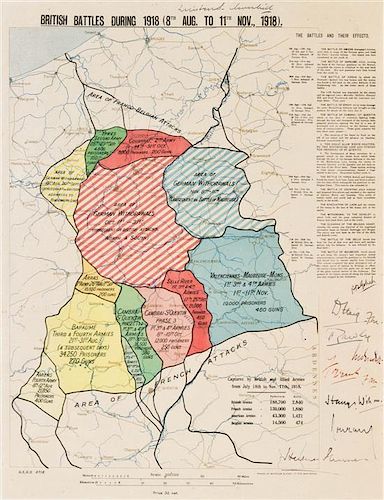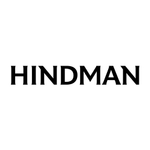* CHURCHILL, SIR WINSTON. Map of British Battles of 1918 signed by Churchill and the other Generals and Field Marshalls.
Lot 174
About Seller
Hindman
1338 West Lake Street
Chicago, IL 60607
United States
Recognized as the Midwest's leading fine art auctioneers, Hindman Auctioneers has built a worldwide reputation based on a full service approach to the auction business tailored to meet the individual needs of our clients. Coming from a variety of educational backgrounds, specialists bring years of e...Read more
Estimate:
$5,000 - $7,000
Absentee vs Live bid
Two ways to bid:
- Leave a max absentee bid and the platform will bid on your behalf up to your maximum bid during the live auction.
- Bid live during the auction and your bids will be submitted real-time to the auctioneer.
Bid Increments
| Price | Bid Increment |
|---|---|
| $0 | $25 |
| $500 | $50 |
| $1,000 | $100 |
| $2,000 | $250 |
| $5,000 | $500 |
| $10,000 | $1,000 |
| $20,000 | $2,500 |
| $50,000 | $5,000 |
| $100,000 | $10,000 |
About Auction
By Hindman
Nov 5, 2014 - Nov 6, 2014
Set Reminder
2014-11-05 10:00:00
2014-11-06 10:00:00
America/New_York
Bidsquare
Bidsquare : Fine Books and Manuscripts
https://www.bidsquare.com/auctions/hindman-auctions/fine-books-and-manuscripts-245
Hindman Bidsquare@hindmanauctions.com
Hindman Bidsquare@hindmanauctions.com
- Lot Description
* CHURCHILL, SIR WINSTON
A color lithograph map entitled British Battles During 1918 (8th Aug. to 11th Nov., 1918). Signed by Churchill in blue ink at the head, the right hand margin signed by General Sir Hubert Gough, Field Marshal Haig, General Rawlinson, General Erich Ludendorff, Field Marshal French, Field Marshal Sir Henry Wilson, General Henri Joseph Eugene Gouraud and General Plumer, the reverse signed by General Sir Walter N. Congreve V.C. Framed and matted.
17 1/2 x 13 1/2 inches.
Estimate $ 5,000-7,000
Property from the Collection of James Bennett, Peru, Illinois
Provenance:
Major Christopher Congreve, youngest son of General Sir Walter N. Congreve, V.C. (1862-1927)
Sold: Christies, South Kensington, April 12, 1996, Lot 42
Literature:
Churchill at this time was minister of munitions in Lloyd George's Government, concentrating on the production of thousands of tanks. The map illustrates the following period of the war when on "August 8 the British Fourth Army, commanded by General Rawlinson, launched a new offensive; British, Canadian and Australian troops all took part... By night fall on August 8 the tank attack had broken through the German front-line trenches; 400 German guns and nearly 22,000 soldiers were captured... By August 10 the British Army had made further advances, taking another 10,000 prisoners. 'The tide has turned,' Churchill wrote to Clementine that day... With each British advance Churchill went to the scene to see how his shells, mustard gas, and tanks had been used, or misused... On October 15, exhausted by the bloodletting, faced with widespread starvation as a result of the Allied sea blockade, and fearing a total collapse of the Balkan front, the Germans asked for an armistice... On November 7 a German delegation crossed into the French lines... On November 10 Lloyd George invited Churchill to a special Cabinet meeting to discuss the course of these negotiations... At 5 o'clock the next morning the Germans accepted the Allied terms" (Martin Gilbert, Churchill, 1991, pp. 393-402). - Shipping Info
-
For more information regarding shipping please visit Leslie Hindman Auctioneers' Shipping and Packing page.
-
- Buyer's Premium



 EUR
EUR CAD
CAD AUD
AUD GBP
GBP MXN
MXN HKD
HKD CNY
CNY MYR
MYR SEK
SEK SGD
SGD CHF
CHF THB
THB



